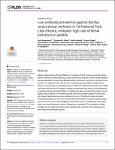Low antibody prevalence against Bacillus cereus biovar anthracis in Taï National Park, Côte d'Ivoire, indicates high rate of lethal infections in wildlife
Zimmermann, Fee
Köhler, Susanne M.
Nowak, Kathrin
Dupke, Susann
Barduhn, Anne
Düx, Ariane
Lang, Alexander
Nys, Hélène M. De
Gogarten, Jan F.
Grunow, Roland
Couacy-Hymann, Emmanuel
Wittig, Roman M.
Klee, Silke
Leendertz, Fabian H.
Bacillus cereus biovar anthracis (Bcbva) is a member of the B. cereus group which carries both B. anthracis virulence plasmids, causes anthrax-like disease in various wildlife species and was described in several sub-Saharan African rainforests. Long-term monitoring of carcasses in Taï National Park, Côte d’Ivoire, revealed continuous wildlife mortality due to Bcbva in a broad range of mammalian species. While non-lethal anthrax infections in wildlife have been described for B. anthracis, nothing is known about the odds of survival following an anthrax infection caused by Bcbva. To address this gap, we present the results of a serological study of anthrax in five wildlife species known to succumb to Bcbva in this ecosystem. Specific antibodies were only detected in two out of 15 wild red colobus monkeys (Procolobus badius) and one out of 10 black-and-white colobus monkeys (Colobus polykomos), but in none of 16 sooty mangabeys (Cercocebus atys), 9 chimpanzees (Pan troglodytes verus) and 9 Maxwell’s duikers (Cephalophus maxwellii). The combination of high mortality and low antibody detection rates indicates high virulence of this disease across these different mammalian species.
Dateien zu dieser Publikation
Keine Lizenzangabe

